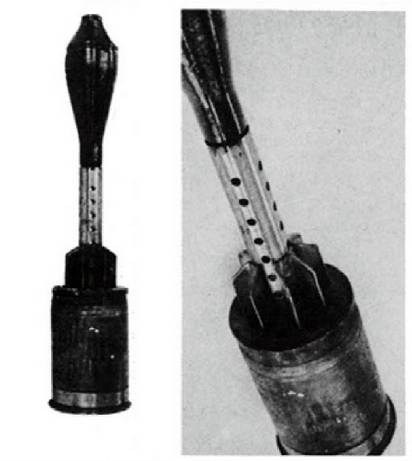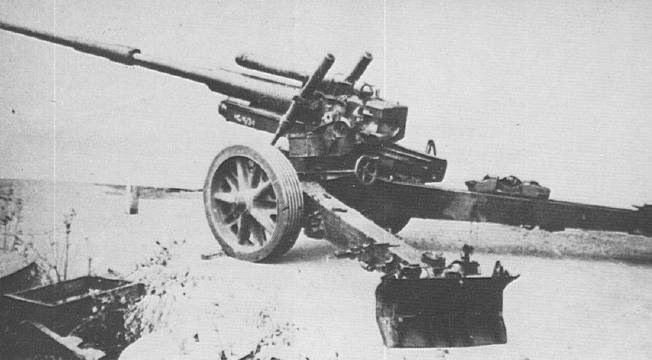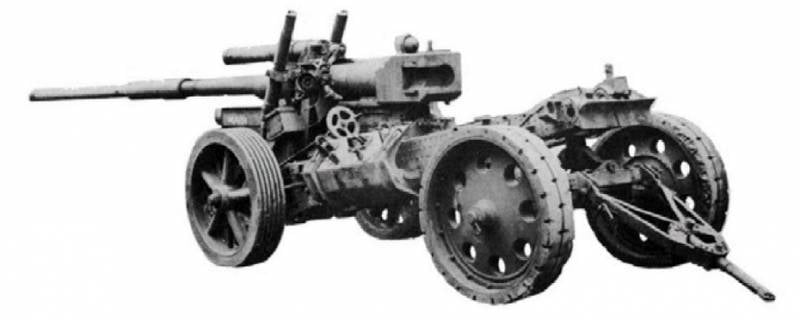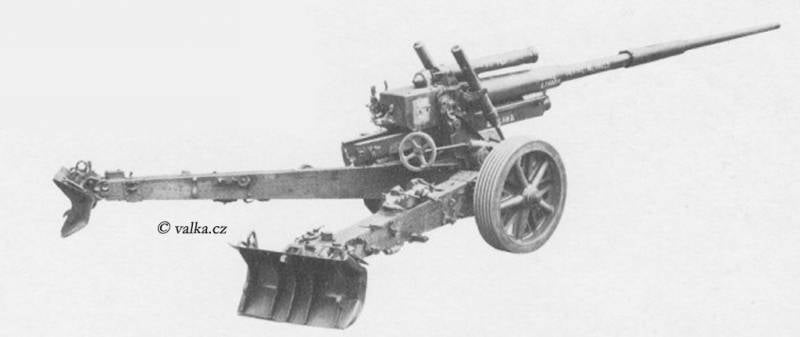Anti-tank gun 8.1 cm Panzerabwehrwerfer L / 105 (Germany)
One of the main goals of the PAW 600 / 8H63 project was to reduce the size and weight of the anti-tank guns as much as possible while obtaining acceptable combat performance. To solve such problems, the designers of the company Rheinmetall-Borsig suggested using a concept known as a low-pressure system or the Hoch-Niederdruk system. In a promising project, it was necessary to use the original ammunition and an unusual way to accelerate the projectile in the barrel. Due to this, it was possible to reduce the requirements for the strength of the barrel, which had a positive effect on the mass of the structure.
According to the test results, the Panzerabwehrwerfer 600 gun was recommended for adoption and serial production. A prerequisite for such a military decision was high operational and combat characteristics. The gun in combat-ready form weighed only 640 kg and could be transported across the battlefield by calculation forces. Moreover, it was able to attack any Tanks the enemy at distances of up to 750 m. The cumulative ammunition pierced up to 143 mm of homogeneous armor in the normal direction.
However, the PAW 600 / 8H63 product had some drawbacks. In connection with the use of a lightweight smooth barrel and an unusual way of creating a working pressure in the chamber, the initial velocity of the projectile, regardless of its type and purpose, was only 520 m / s. Stabilization of ammunition in flight was carried out by rotation, with the help of its tail planes. Among other things, this led to insufficient accuracy of the fire. Thus, at a distance of 750 m, the gun confidently hit a target of size 1х1 m, however half of the shells did not fit into the 70x70 square. See
Already at the end of 1944 of the year, almost simultaneously with the launch of the mass production of the first gun of the new kind, the Rheinmetall-Borsig company began work on the second project. Using the solutions already tested in practice, it was planned to create a new version of the low-pressure tool, featuring higher characteristics. First of all, it was supposed to increase the initial velocity of the projectile, which could result in an increase in the range and accuracy of the fire. At the same time, it was necessary to ensure a certain unification of the existing sample and the perspective one.
The essence of the new project was to increase the length of the barrel while maintaining other basic design features. This fact was noted in the working title of the new gun. It was designated as 8.1 cm Panzerabwehrwerfer L / 105 - “81-mm anti-tank launcher caliber with a barrel length 105 caliber”. It is curious that the creators of promising projects have designated their two guns as launchers, but not as guns.
The new PAW L / 105 gun was supposed to use existing ammunition. Earlier, in the framework of the PAW 600 project, a cumulative anti-tank missile Pwk.Gr. was created. 5071, used as part of the Wgr.Patr unitary shot. 4462. The original projectile was created based on a standard 81-mm mortar mine and retained some of its units. So, the tubular shank with several rows of holes in the walls, equipped with a stabilizer in the form of several small planes, remained unchanged. The main body of the existing mine was redesigned. To obtain the desired results, designers have changed its shape.
The cumulative ammunition had a mass of 3,75 kg and carried a charge of explosive with a mass of 2,7 kg, which had a special form. The applied shaped charge could penetrate up to 143 mm of homogeneous armor when hit at a right angle. Thus, the projectile Pwk.Gr. 5071 could hit any serial tank of the anti-Hitler coalition.

Shot Wgr.Patr. 4462 cumulative projectile Pwk.Gr. 5071. Photo Strangernn.livejournal.com
Also in the shot Wgr.Patr. The 4462 was a propellant liner. It was a metal cup with a solid top lid, which had eight holes. Inside the liner was placed 360 g of gunpowder. The special design of the liner was associated with the original principle of the gun.
To obtain the desired increase in the initial velocity of the projectile, it was proposed to use a smooth barrel with a length of 105 gauges (8,5 m). Unlike the previous gun, the new one did not come with a muzzle brake. At the same time, a characteristic large tubular ejector appeared in the central part of the trunk. This feature of the project suggests that the new gun 8.1 cm Panzerabwehrwerfer L / 105 was developed not only in the interests of field artillery, but also for tanks. The breech breech, as before, had a rectangular cross section and contained a movable vertical wedge gate. A semi-automatic system was used, which independently threw out an empty sleeve.
An important feature of the instrument was the characteristic design of the chamber. Its front part had a diameter of 81,4 mm and was intended for a projectile. The rear chamber volume was distinguished by its large size. The ledge between the two cylindrical surfaces served as a stop for the front cover of the liner.
A prototype of the PAW L / 105 anti-tank gun was proposed to be built on the basis of the existing 105 gun carriage 10,5 cm leFH 18M howitzer, supplemented with some details of the gun carriage of the 10 cm field gun 18. The finished carriage had a small platform with a sprung wheel course, on which sliding beds with large openers were hinged. The carriage was equipped with a movable U-shaped support for mounting the rocking artillery unit. Due to the large mass of the barrel group of the original howitzer, the carriage was completed with vertically arranged balancing devices. The gun was mounted on the cradle, moving along the longitudinal beam guide. Its movements were controlled by hydropneumatic recoil devices.
When translated into the stowed position, the frame of the mast was reduced and fixed on a uniaxial front end. The latter had a towing frame, with which the 10,5 gun cm leFH 18M or PAW L / 105 could be transported by any suitable transport.
The selected carriage was equipped with drives of vertical and horizontal guidance, controlled by a pair of flywheels. Manual gun guidance was provided within the horizontal sector of width 64 °. Elevation angles varied from 0 ° to + 48 °. Such mast parameters made it possible to use a promising weapon both in the original anti-tank role and for firing high-explosive shells at a long range, including from closed positions.
For aiming the guns, a new sight, based on one of the production models and designed for 81-mm projectile ballistics, was to be used. The sight was located to the left of the breech gun. The gunner’s workplace was also there. The aiming control was carried out using a pair of flywheels, spaced on opposite sides of the central guide carriage.
In its principle of operation, the new 8.1 cm Panzerabwehrwerfer L / 105 gun did not differ from the previous PAW 600 / 8H63. After being deployed in position, the gun should have been loaded by placing a unitary shot into the chamber. In this case, the projectile entered into the front chamber of a smaller diameter, and the sleeve remained outside, in its own volume. Closing the shutter allows you to shoot. Pressing the trigger lever triggered the mechanisms and ignited powder charge.
Burning inside the liner, the powder was supposed to emit a large amount of gases and develop pressure up to 1200 kg / sq. Cm (about 117,7 MPa). When a certain pressure was reached, the gases broke through the membranes of the front cover of the liner and fell into the front of the chamber, where the projectile was ready to fire. Due to the correctly chosen shape and size of the holes in the lid, as well as due to the difference in volumes, the pressure behind the projectile dropped to 550 kg / sq. Cm (54 MPa). The projectile accelerated and left the barrel.
The original method of supplying powder gases to the projectile gave certain advantages. Unlike the “traditional” gun, the new PAW 600 and PAW L / 105 guns did not need a strong and heavy barrel capable of withstanding high pressure. Until the release of the projectile from the barrel, the pressure in the channel of the latter was maintained at the same level, which made acceleration more efficient and allowed to obtain, in general, quite good characteristics. At the same time, the barrel design and the acceleration method imposed restrictions on the maximum velocity of the projectile. This problem was leveled by the use of cumulative munitions, the power of which did not depend on the speed of flight.
According to known data, the development of a new gun, characterized by an increased barrel length, began at the end of 1944 of the year and ended in the first months of 1945. Having completed the design work, the company Rheinmetall-Borsig began to build a prototype. The trunk of the new design imposed on the carriage, built from the available units. In this form, the low-pressure gun 8.1 cm Panzerabwehrwerfer L / 105 went to the testing ground. Apparently, this happened at the end of winter or at the beginning of spring 1945 of the year.
There is information about some tests, but there is no exact information on this. The project appeared in a very difficult period, and therefore the tests could simply not take place. If the gun reached the test site and was able to proceed with the checks, then it was able to demonstrate good results. The PAW L / 105 gun could be at least as good as the serial 8H63, aided by a modified barrel design.

Gun at the site. Photo Ftr.wot-news.com
The first German low-pressure smooth-bore gun for Pwk.Gr. projectile. 5071, equipped with a lightweight barrel length 38 caliber, had, in general, good performance. It dispersed ammunition up to speed 520 m / s and could hit tanks at a range of 750 m. When using a high-explosive fragmentation projectile, the maximum firing range reached 6200 m. The new project envisaged a dramatic increase in the length of the barrel, which should have clear consequences. The exact numbers, however, are unknown.
It can be assumed that the new PAW L / 105 can demonstrate a significant increase in the initial velocity of the projectile. In combination with the stabilizer used, this could lead to an increase in the accuracy of the fire at main distances. It can also be assumed that the promising gun could differ significantly increased the effective range of fire. Thus, in terms of its combat characteristics, the new smooth-bore system had to surpass the existing model. However, the exact characteristics of the later cannon remain unknown, and in this matter we have to rely only on estimates.
Anyway, a promising anti-tank gun could not pass the test. The prototype of the new model was built too late. Just a few weeks after its introduction, all new projects have lost all meaning. The tests of the PAW L / 105 cannon did not have time to complete before the end of the war and the surrender of Germany. Obviously, in such conditions, the adoption and launch of mass production was impossible.
Apparently, only one 8.1 cm Panzerabwehrwerfer L / 105 gun was built for testing. Her fate is not known for certain. Probably, the experts of the winning countries could study the trophy sample and draw some conclusions. In the future, however, the most interesting weapon in some circumstances ceased to exist. Any information about the preservation of this product or its transfer to the museum is missing.
In the framework of the first project, the low-pressure guns of the Hoch-Niderdruk system, the designers of the Rheinmetall-Borzig company, created an interesting enough sample of anti-tank guns, distinguished by high operational and combat characteristics. A further development of this project was the gun PAW L / 105, which was different in other design and had every chance to show even higher performance. However, the second sample was developed too late. Any German project created at the beginning of 1945, by definition, was doomed to failure. Shortly after the appearance of an experienced cannon of a new type, Germany capitulated and lost any opportunity to continue work on interesting topics.
Based on:
http://lexikon-der-wehrmacht.de/
https://weaponsandwarfare.com/
http://ftr.wot-news.com/
https://strangernn.livejournal.com/
Hogg, Ian V. German Artillery of World War Two. 2nd corrected edition. Mechanicsville, PA: Stackpole Books, 1997


Information